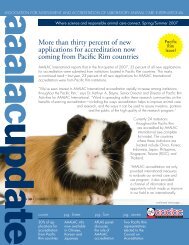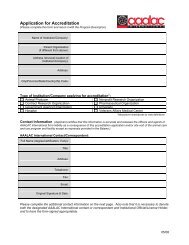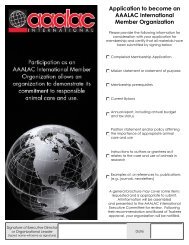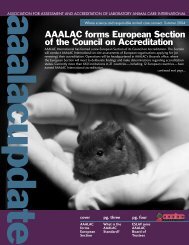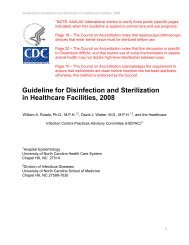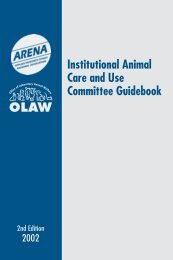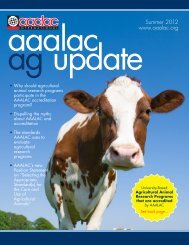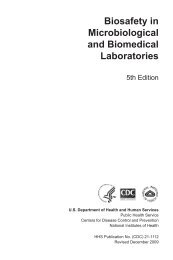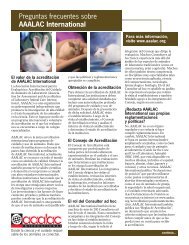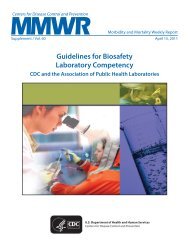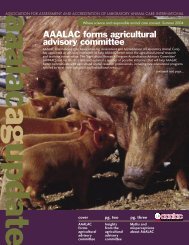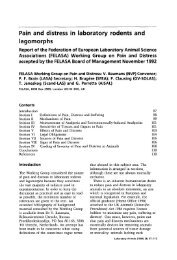14 CHAPTER 2exposed to <strong>the</strong>se chemicals. Examples are pesticides <strong>for</strong><strong>in</strong>sect control, herbicides, poisons <strong>for</strong> rodent control,wood preservatives, <strong>and</strong> dis<strong>in</strong>fectants. Harmful productsshould be properly labeled <strong>and</strong> stored, a record<strong>of</strong> <strong>the</strong>ir purchase <strong>and</strong> expiration dates should be kept,<strong>and</strong> personnel must be <strong>in</strong><strong>for</strong>med <strong>of</strong> potential hazards<strong>and</strong> wear appropriate protective equipment. Chemicalsmust be stored, used, <strong>and</strong> disposed <strong>of</strong> <strong>in</strong> a manner thatprevents contam<strong>in</strong>ation <strong>of</strong> animals <strong>and</strong> residues <strong>in</strong> milk,meat, or eggs.<strong>in</strong>clud<strong>in</strong>g abortions, large <strong>of</strong>fspr<strong>in</strong>g, enlarged umbilicus,reta<strong>in</strong>ed placenta, hydrops, multiple births, <strong>and</strong> placentade<strong>for</strong>mities. The scientist is responsible <strong>for</strong> identify<strong>in</strong>gphysiologic <strong>and</strong> phenotypic changes <strong>and</strong> must havea plan to address changes that affect animal health t<strong>of</strong>acilitate <strong>and</strong> ensure animal welfare.The US FDA is responsible <strong>for</strong> approv<strong>in</strong>g <strong>the</strong> use <strong>of</strong>genetically modified foods <strong>in</strong> <strong>the</strong> United States under<strong>the</strong> Food, Drug, <strong>and</strong> Cosmetic Act <strong>of</strong> 1992 (FDCA; 21U.S.C. §301 et seq).RESTRAINTBrief physical restra<strong>in</strong>t <strong>of</strong> agricultural animals <strong>for</strong> exam<strong>in</strong>ation,collection <strong>of</strong> samples, <strong>and</strong> a variety <strong>of</strong> o<strong>the</strong>rexperimental <strong>and</strong> cl<strong>in</strong>ical manipulations can be accomplishedmanually or with devices such as stocks, headgates, stanchions, or squeeze chutes. It is important thatsuch devices be suitable <strong>in</strong> size <strong>and</strong> design <strong>for</strong> <strong>the</strong> animalbe<strong>in</strong>g held <strong>and</strong> be operated properly to m<strong>in</strong>imizestress <strong>and</strong> avoid pa<strong>in</strong> <strong>and</strong> <strong>in</strong>jury (Gr<strong>and</strong><strong>in</strong>, 1983a,b).Refer to Chapter 5: Animal H<strong>and</strong>l<strong>in</strong>g <strong>and</strong> Transport<strong>for</strong> additional <strong>in</strong><strong>for</strong>mation. Personnel should be tra<strong>in</strong>edon <strong>the</strong> use <strong>of</strong> hydraulically operated restra<strong>in</strong>t devicesto prevent potential <strong>in</strong>jury. Extended physical restra<strong>in</strong>tshould be reviewed <strong>and</strong> approved by <strong>the</strong> IACUC.TRANSGENIC AND GENETICALLYENGINEERED AND CLONEDANIMALSRecent years have seen a grow<strong>in</strong>g <strong>in</strong>terest <strong>in</strong> <strong>the</strong> development<strong>and</strong> use <strong>of</strong> transgenic <strong>and</strong> genetically modifiedagricultural animals <strong>for</strong> agricultural <strong>and</strong> human<strong>the</strong>rapeutic purposes. A transgenic animal is one thatcarries a <strong>for</strong>eign gene that has been deliberately <strong>in</strong>serted<strong>in</strong>to its genome. Genetically eng<strong>in</strong>eered animal modelsrequire deliberate modification <strong>of</strong> <strong>the</strong> animal genomeby mov<strong>in</strong>g a desired trait <strong>in</strong>to <strong>the</strong> genome. These modificationsare accomplished by micro<strong>in</strong>jection, retroviraltransfection, <strong>and</strong> a variety <strong>of</strong> o<strong>the</strong>r techniques.It is important not to confuse genetically eng<strong>in</strong>eeredanimals with cloned animals. Genetically eng<strong>in</strong>eeredanimals may be produced by clon<strong>in</strong>g as well as o<strong>the</strong>rtechniques noted above. The progeny <strong>of</strong> cloned animalsare not properly termed “cloned animals.” It is also importantto dist<strong>in</strong>guish between research <strong>and</strong> commercialapplication <strong>of</strong> clon<strong>in</strong>g techniques. Clon<strong>in</strong>g technologyhas been reviewed by <strong>the</strong> FDA <strong>and</strong> is one <strong>of</strong> severalcommercially available assisted reproductive technologies<strong>in</strong>clud<strong>in</strong>g <strong>in</strong> vitro fertilization <strong>and</strong> embryo transfer(FDA, 2008, 2009). As advancements <strong>in</strong> researchcont<strong>in</strong>ue <strong>and</strong> new technologies are developed, specificconsiderations may need to be made <strong>for</strong> <strong>the</strong> care <strong>and</strong>use <strong>of</strong> agricultural animals.Both transgenic <strong>and</strong> genetically eng<strong>in</strong>eered animalmodels may have physiologic or phenotypic problemsEUTHANASIAProtocols <strong>for</strong> euthanasia should follow current guidel<strong>in</strong>esestablished by <strong>the</strong> American Veter<strong>in</strong>ary MedicalAssociation (AVMA; www.avma.org) <strong>and</strong> copies <strong>of</strong><strong>the</strong> protocols should be made available to all personnelwho euthanize animals. The agents <strong>and</strong> methods<strong>of</strong> euthanasia appropriate <strong>for</strong> agricultural animals areavailable <strong>in</strong> <strong>the</strong> AVMA (2007) <strong>Guide</strong>l<strong>in</strong>es <strong>for</strong> Euthanasia(http:www.avma.org/issues/animal_welfare/euthanasia.pdf) or subsequent revisions <strong>of</strong> that document.Refer to Chapters 6 through 11 <strong>for</strong> species-specific<strong>in</strong><strong>for</strong>mation on euthanasia <strong>and</strong> slaughter.Euthanasia is <strong>the</strong> procedure <strong>of</strong> kill<strong>in</strong>g an animal rapidly,pa<strong>in</strong>lessly, <strong>and</strong> without distress. Euthanasia mustbe carried out by tra<strong>in</strong>ed personnel us<strong>in</strong>g acceptabletechniques <strong>in</strong> accordance with applicable regulations<strong>and</strong> policies. The method used should not <strong>in</strong>terfere withpostmortem evaluations. Proper euthanasia <strong>in</strong>volvesskilled personnel to help ensure that <strong>the</strong> technique isper<strong>for</strong>med humanely <strong>and</strong> effectively <strong>and</strong> to m<strong>in</strong>imizerisk <strong>of</strong> <strong>in</strong>jury to people. Personnel who per<strong>for</strong>m euthanasiamust have tra<strong>in</strong><strong>in</strong>g <strong>and</strong> experience with <strong>the</strong> techniquesto be used. This tra<strong>in</strong><strong>in</strong>g <strong>and</strong> experience must<strong>in</strong>clude familiarity with <strong>the</strong> normal behavior <strong>of</strong> agriculturalanimals <strong>and</strong> how h<strong>and</strong>l<strong>in</strong>g <strong>and</strong> restra<strong>in</strong>t affect<strong>the</strong>ir behavior. The equipment <strong>and</strong> materials requiredto per<strong>for</strong>m euthanasia should be readily available, <strong>and</strong><strong>the</strong> attend<strong>in</strong>g veter<strong>in</strong>arian or a qualified animal scientistshould ensure that all personnel per<strong>for</strong>m<strong>in</strong>g euthanasiahave demonstrated pr<strong>of</strong>iciency <strong>in</strong> <strong>the</strong> use <strong>of</strong> <strong>the</strong>techniques selected.Acceptable methods <strong>of</strong> euthanasia are those that <strong>in</strong>itiallydepress <strong>the</strong> central nervous system to ensure <strong>in</strong>sensitivityto pa<strong>in</strong> (Canadian Council on Animal <strong>Care</strong>,1980). Euthanasia techniques should result <strong>in</strong> rapid unconsciousnessfollowed by cardiac or respiratory arrest<strong>and</strong> <strong>the</strong> ultimate loss <strong>of</strong> bra<strong>in</strong> function. In addition, <strong>the</strong>technique used should m<strong>in</strong>imize any stress <strong>and</strong> anxietyexperienced by <strong>the</strong> animal be<strong>for</strong>e unconsciousness(AVMA, 2007). For this reason, anes<strong>the</strong>tic agents aregenerally acceptable, <strong>and</strong> animals <strong>of</strong> most species canbe quickly <strong>and</strong> humanely euthanized with <strong>the</strong> appropriate<strong>in</strong>jection <strong>of</strong> an overdose <strong>of</strong> a barbiturate. Certa<strong>in</strong>o<strong>the</strong>r methods may be used <strong>for</strong> euthanasia <strong>of</strong> anes<strong>the</strong>tizedanimals because <strong>the</strong> major criterion (<strong>in</strong>sensibility)has been fulfilled (Lucke, 1979).
Physical methods <strong>of</strong> euthanasia (e.g., penetrat<strong>in</strong>gcaptive-bolt devices <strong>for</strong> large animals) may be used. Everyattempt should be made to m<strong>in</strong>imize stress to <strong>the</strong>animal be<strong>for</strong>e euthanasia. Personnel must be tra<strong>in</strong>ed on<strong>the</strong> proper use <strong>of</strong> <strong>the</strong> captive bolt per species, <strong>and</strong> <strong>the</strong>captive bolt device must be appropriately ma<strong>in</strong>ta<strong>in</strong>ed.Electrocution is an acceptable means <strong>of</strong> euthanasiaif <strong>the</strong> electrodes are placed so that <strong>the</strong> current travelsthrough <strong>the</strong> bra<strong>in</strong> <strong>and</strong> through <strong>the</strong> heart. Methods <strong>in</strong>which <strong>the</strong> current is directed through <strong>the</strong> heart only arenot acceptable (www.gr<strong>and</strong><strong>in</strong>.com). It is imperative toensure that <strong>the</strong> animal is <strong>in</strong>deed dead (i.e., no heartbeat<strong>and</strong> no possibility <strong>of</strong> recovery). Techniques thatapply electric current from head to tail, head to foot,or head to moistened metal plates on which <strong>the</strong> animalis st<strong>and</strong><strong>in</strong>g are unacceptable (AVMA, 2007).Agents that result <strong>in</strong> tissue residues cannot be used<strong>for</strong> euthanasia <strong>of</strong> animals <strong>in</strong>tended <strong>for</strong> human or animalfood unless those agents are approved by <strong>the</strong> FDA.Carbon dioxide is <strong>the</strong> only chemical currently used <strong>for</strong>euthanasia <strong>of</strong> food animals (primarily sw<strong>in</strong>e <strong>and</strong> poultry)that does not lead to tissue residues. The carcasses<strong>of</strong> animals euthanized by barbiturates may conta<strong>in</strong> potentiallyharmful residues <strong>and</strong> should be disposed <strong>of</strong> <strong>in</strong>a manner that prevents <strong>the</strong>m from be<strong>in</strong>g consumed byhuman be<strong>in</strong>gs or animals.No matter what method <strong>of</strong> euthanasia is per<strong>for</strong>med,personnel must ensure that death has occurred. Assurance<strong>of</strong> death may <strong>in</strong>clude ascerta<strong>in</strong><strong>in</strong>g <strong>the</strong> absence <strong>of</strong>heartbeat <strong>and</strong> respiration, lack <strong>of</strong> corneal or o<strong>the</strong>r reflexes,<strong>and</strong> lack <strong>of</strong> physical movement. Personnel shouldbe tra<strong>in</strong>ed on how to assure death <strong>in</strong> animals.Humane SlaughterSlaughter <strong>of</strong> animals enter<strong>in</strong>g <strong>the</strong> human food cha<strong>in</strong>must be accomplished <strong>in</strong> compliance with regulationspromulgated under <strong>the</strong> federal Humane Methods <strong>of</strong>Slaughter Act (9 CFR. 313.1–90; CFR, 1987). Theseregulations outl<strong>in</strong>e <strong>the</strong> requirements <strong>for</strong> <strong>the</strong> humanetreatment <strong>of</strong> livestock be<strong>for</strong>e <strong>and</strong> dur<strong>in</strong>g slaughter(http://www.animallaw.<strong>in</strong>fo/adm<strong>in</strong>istrative/adus9cfr313.htm).The Food Safety <strong>and</strong> Inspection Service is<strong>the</strong> agency with<strong>in</strong> <strong>the</strong> USDA responsible <strong>for</strong> ensur<strong>in</strong>gcompliance with this Act.When stunn<strong>in</strong>g is used dur<strong>in</strong>g slaughter, stunn<strong>in</strong>gmust be done appropriately <strong>and</strong> effectively. Allequipment <strong>for</strong> stunn<strong>in</strong>g must be properly ma<strong>in</strong>ta<strong>in</strong>ed,<strong>and</strong> personnel per<strong>for</strong>m<strong>in</strong>g stunn<strong>in</strong>g must be properlytra<strong>in</strong>ed, <strong>in</strong>clud<strong>in</strong>g <strong>in</strong>struction <strong>in</strong> assess<strong>in</strong>g <strong>in</strong>sensibility.AGRICULTURAL ANIMAL HEALTH CAREThe use <strong>of</strong> carbon dioxide alone or <strong>in</strong> comb<strong>in</strong>ation witho<strong>the</strong>r gaseous <strong>in</strong>halants rema<strong>in</strong>s controversial.REFERENCESAmerican College <strong>of</strong> Laboratory Animal Medic<strong>in</strong>e (ACLAM). 2004.Public Statements: Medical records <strong>for</strong> animals used <strong>in</strong> research,teach<strong>in</strong>g <strong>and</strong> test<strong>in</strong>g. http://www.aclam.org/aclam_public.html.AVMA. 2007. <strong>Guide</strong>l<strong>in</strong>es on Euthanasia. http://www.avma.org/issues/animal_welfare/euthanasia.pdfBrown, M. J., P. T. Pearson, <strong>and</strong> F. N. Tomson. 1993. <strong>Guide</strong>l<strong>in</strong>es<strong>for</strong> animal surgery <strong>in</strong> research <strong>and</strong> teach<strong>in</strong>g. Am. J. Vet. Res.54:1544–1559.Canadian Council on Animal <strong>Care</strong>. 1980. <strong>Guide</strong> to <strong>the</strong> <strong>Care</strong> <strong>and</strong><strong>Use</strong> <strong>of</strong> Experimental <strong>Animals</strong>. Vol. 1. Can. Counc. Anim. <strong>Care</strong>,Ottawa, ON, Canada.CFR. 1987. Title 21 CFR Parts 511 <strong>and</strong> 514. US Govt. Pr<strong>in</strong>t<strong>in</strong>g Office.Wash<strong>in</strong>gton, DC.FDA. 2008. Animal Clon<strong>in</strong>g: A Risk Assessment, FDA, 2008.http://www.fda.gov/downloads/AnimalVeter<strong>in</strong>ary/SafetyHealth/AnimalClon<strong>in</strong>g/UCM124756.pdfFDA. 2009. FDA Guidance 187: Guidance <strong>for</strong> Industry on Regulation<strong>of</strong> Genetically Eng<strong>in</strong>eered <strong>Animals</strong> Conta<strong>in</strong><strong>in</strong>g HeritableRecomb<strong>in</strong>ant DNA Constructs; Availability. Docket No. FDA-2008-D-0394. Fed. Regist. 74(11):3057–3058.Field, K., M. Bailey, L. Foresman, R. Harris, S. Motzel, R. Rockar,G. Ruble, <strong>and</strong> M. Suckow. 2007. Medical Records <strong>for</strong> <strong>Animals</strong>used <strong>in</strong> <strong>Research</strong>, Teach<strong>in</strong>g <strong>and</strong> Test<strong>in</strong>g: Public Statement from<strong>the</strong> American College <strong>of</strong> Laboratory Animal Medic<strong>in</strong>e. ILARJ. 48:37–41.Gr<strong>and</strong><strong>in</strong>, T. 1983a. Design <strong>of</strong> ranch corrals <strong>and</strong> squeeze chutes <strong>for</strong>cattle. Pages 5251.1–5251.6 <strong>in</strong> Great Pla<strong>in</strong>s Beef Cattle H<strong>and</strong>book.Cooperative Extension Service, Oklahoma State University,Stillwater.Gr<strong>and</strong><strong>in</strong>, T. 1983b. Welfare requirements <strong>of</strong> h<strong>and</strong>l<strong>in</strong>g facilities. Pages137–149 <strong>in</strong> Farm Animal Hous<strong>in</strong>g <strong>and</strong> Welfare. S. H. Baxter,M. R. Baxter, <strong>and</strong> J. A. G. McCormack, ed. Mart<strong>in</strong>us Nijh<strong>of</strong>f,Boston, MA.ILAR <strong>Guide</strong>. 1996. <strong>Guide</strong> <strong>for</strong> <strong>the</strong> <strong>Care</strong> <strong>and</strong> <strong>Use</strong> <strong>of</strong> Laboratory <strong>Animals</strong>.Institute <strong>of</strong> Laboratory Animal Resources, National <strong>Research</strong>Council. National Academy Press, Wash<strong>in</strong>gton, DC.Lucke, J. N. 1979. Euthanasia <strong>in</strong> small animals. Vet. Rec. 104:316–318.Radostits, O. M., D. C. Blood, <strong>and</strong> C. C. Gay. 1994. Veter<strong>in</strong>aryMedic<strong>in</strong>e. 8th ed. Baillière T<strong>in</strong>dall, London, UK.Upson, D. W. 1985. H<strong>and</strong>book <strong>of</strong> Cl<strong>in</strong>ical Veter<strong>in</strong>ary Pharmacology.2nd ed. Veter<strong>in</strong>ary Medic<strong>in</strong>e Publ., Lenexa, KS.Van Sambeek, F., B. L. McMurray, <strong>and</strong> R. K. Page. 1995. Incidence<strong>of</strong> Pasteurella multocida <strong>in</strong> poultry house cats used <strong>for</strong> rodentcontrol programs. Avian Dis. 39:145–146.Van’t Woudt, B. D. 1990. Roam<strong>in</strong>g, stray, <strong>and</strong> feral domestic cats<strong>and</strong> dogs as wildlife problems. Vertebrate Pest Conference Proceed<strong>in</strong>gsCollection. University <strong>of</strong> Nebraska, L<strong>in</strong>coln.Vantassel, S., S. Hygnstrom, <strong>and</strong> D. Ferraro. 2005. Controll<strong>in</strong>g housemice. Neb<strong>Guide</strong>, University <strong>of</strong> Nebraska-L<strong>in</strong>coln Extension, Institute<strong>of</strong> Agriculture <strong>and</strong> Natural resources. University <strong>of</strong> Nebraska,L<strong>in</strong>coln.15
- Page 1 and 2: Guide for the Care and Useof Agricu
- Page 3 and 4: Guide Revision Committees for the F
- Page 5 and 6: Chapter 6: Beef Cattle 61Facilities
- Page 7: PrefaceThis is the third edition of
- Page 10 and 11: 2 CHAPTER 1The IACUC should meet at
- Page 12 and 13: 4 CHAPTER 1tion Center at the Natio
- Page 14 and 15: 6 CHAPTER 1Disposition of Animal Cl
- Page 16 and 17: Chapter 2: Agricultural Animal Heal
- Page 18 and 19: 10 CHAPTER 2and behavioral health e
- Page 20 and 21: 12 CHAPTER 2care attendants or rese
- Page 24 and 25: Chapter 3: Husbandry, Housing, and
- Page 26 and 27: 18 CHAPTER 3Most agricultural anima
- Page 28 and 29: 20 CHAPTER 3gases, particulates, an
- Page 30 and 31: 22 CHAPTER 3in pairs or groups when
- Page 32 and 33: 24 CHAPTER 3screened with 1.3-cm (0
- Page 34 and 35: 26 CHAPTER 3priate, and institution
- Page 36 and 37: 28 CHAPTER 3ings and Deliberations.
- Page 38 and 39: Chapter 4: Environmental Enrichment
- Page 40 and 41: 32 CHAPTER 4(Feh and de Mazieres, 1
- Page 42 and 43: 34 CHAPTER 4Substrate: The provisio
- Page 44 and 45: 36 CHAPTER 4mize regrouping and soc
- Page 46 and 47: 38 CHAPTER 4not especially attracte
- Page 48 and 49: 40 CHAPTER 4Croney, C. C., K. M. Ad
- Page 50 and 51: 42 CHAPTER 4Meunier-Salaün, M. C.,
- Page 52 and 53: 44 CHAPTER 4Wilson, S. C., F. M. Mi
- Page 54 and 55: 46 CHAPTER 5dling facility in the f
- Page 56 and 57: 48 CHAPTER 5Table 5-1. Visual distr
- Page 58 and 59: 50 CHAPTER 5Animals should be handl
- Page 60 and 61: 52 CHAPTER 5be given during conditi
- Page 62 and 63: 54 CHAPTER 5mercial broiler farms,
- Page 64 and 65: 56 CHAPTER 5The condition of the an
- Page 66 and 67: 58 CHAPTER 5Arnold, G. W. 1977. An
- Page 68 and 69: 60 CHAPTER 5for veterinary and husb
- Page 70 and 71: 62 CHAPTER 6managers of confined ca
- Page 72 and 73:
64 CHAPTER 6Cold housing can be pro
- Page 74 and 75:
66 CHAPTER 6HUSBANDRYAdequate care
- Page 76 and 77:
68 CHAPTER 6ately to perform a caes
- Page 78 and 79:
70 CHAPTER 6minimum amount of time
- Page 80 and 81:
72 CHAPTER 6Ensminger, M. E. 1970.
- Page 82 and 83:
Chapter 7: Dairy CattleDairy cattle
- Page 84 and 85:
76 CHAPTER 7Table 7-1. Recommended
- Page 86 and 87:
78 CHAPTER 7ties should be provided
- Page 88 and 89:
80 CHAPTER 7quent feeding, and exce
- Page 90 and 91:
82 CHAPTER 7hanced sensitivity to h
- Page 92 and 93:
84 CHAPTER 7effective for removing
- Page 94 and 95:
86 CHAPTER 7Albright, J. L. 1978. S
- Page 96 and 97:
88 CHAPTER 7Murphy, M. R., C. L. Da
- Page 98 and 99:
Chapter 8: HorsesMost horses are us
- Page 100 and 101:
92 CHAPTER 8Temperature and Ventila
- Page 102 and 103:
94 CHAPTER 8tritional programs for
- Page 104 and 105:
96 CHAPTER 8WaterClean water should
- Page 106 and 107:
98 CHAPTER 8bots (Gastrophilus inte
- Page 108 and 109:
100 CHAPTER 8STANDARD AGRICULTURALP
- Page 110 and 111:
102 CHAPTER 8of Animals. C. McGowan
- Page 112 and 113:
104 CHAPTER 9dom of movement, runni
- Page 114 and 115:
106 CHAPTER 92006). Developing bree
- Page 116 and 117:
108 CHAPTER 9Table 9-3. Minimum fee
- Page 118 and 119:
110 CHAPTER 9Table 9-7. Minimum dri
- Page 120 and 121:
112 CHAPTER 9Table 9-10. Minimum fl
- Page 122 and 123:
114 CHAPTER 9Table 9-12. Minimum fl
- Page 124 and 125:
116 CHAPTER 9ery effort should be m
- Page 126 and 127:
118 CHAPTER 9guides, available from
- Page 128 and 129:
120 CHAPTER 9nutritive pecking decr
- Page 130 and 131:
122 CHAPTER 9rapidly fragmented by
- Page 132 and 133:
124 CHAPTER 9Brambell, F. W. R. 196
- Page 134 and 135:
126 CHAPTER 9Hughes, B. O., and M.
- Page 136 and 137:
128 CHAPTER 9chickens grown with tw
- Page 138 and 139:
130 CHAPTER 10Table 10-1. Recommend
- Page 140 and 141:
132 CHAPTER 10prevented or minimize
- Page 142 and 143:
134 CHAPTER 10and well-being (Matte
- Page 144 and 145:
136 CHAPTER 10via colostrum (de la
- Page 146 and 147:
138 CHAPTER 10thoroughly at the beg
- Page 148 and 149:
140 CHAPTER 10Ames, D. R., J. E. Ne
- Page 150 and 151:
142 CHAPTER 102006. Semen and repro
- Page 152 and 153:
144 CHAPTER 11Table 11-1. Recommend
- Page 154 and 155:
146 CHAPTER 11vided in the creep ar
- Page 156 and 157:
148 CHAPTER 11Table 11-2. Minimum f
- Page 158 and 159:
150 CHAPTER 11are kept in small gro
- Page 160 and 161:
152 CHAPTER 11sonable to consolidat
- Page 162 and 163:
154 CHAPTER 11Blackshaw, J. K., F.
- Page 164 and 165:
156 CHAPTER 11populations structure
- Page 166 and 167:
Appendix 2Table A-1. Zoonotic disea
- Page 168 and 169:
IndexAAABP (American Association of
- Page 170 and 171:
162 INDEXcold climates. See also te
- Page 172 and 173:
164 INDEXdairy, 137disbudding of, 1
- Page 174 and 175:
166 INDEXmisters, 19mites, 98Model
- Page 176 and 177:
168 INDEXin horse stalls, 90in poul



